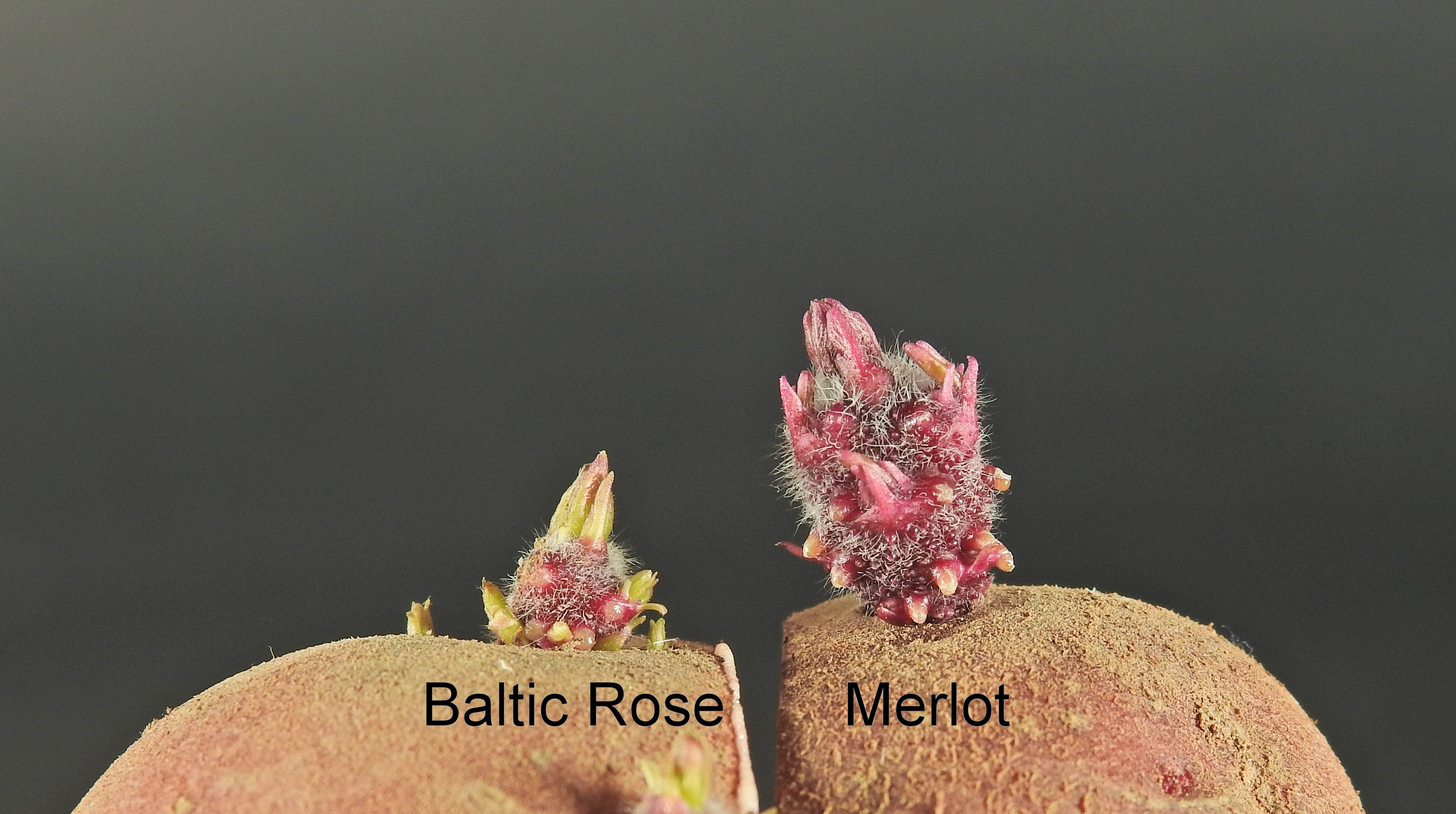Baltic Rose
| Denomination: | 'Baltic Rose' |
|---|---|
| Botanical Name: | Solanum tuberosum |
| Applicant/Holder: |
Norika Nordring Kartoffelzucht und Vermehrungs GmbH Parkweg 4 D-18190, Sanitz Gross Lüsewitz Germany |
| Breeder: |
Norika Nordring Kartoffelzucht und Vermehrungs GmbH, Gross Lüsewitz, Germany |
| Agent in Canada: |
Global Agri Services Inc. 376 New Maryland Highway New Maryland, New Brunswick E3C 1E5 Canada Tel: 506-462-9493 |
| Application Date: | 2020-05-14 |
| Provisional Protection:: | 2020-05-14 |
| Application Number: | 20-10240 |
| Grant of Rights Date: | 2023-02-15 |
| Certificate Number: | 6779 |
| Grant of Rights Termination Date: | 2043-02-15 |
Variety Description
Variety used for comparison: 'Merlot'
Summary: The lightsprout of 'Baltic Rose' is small, spherical in shape and has few root tips while that of 'Merlot' is medium in size, ovoid and has a medium number of root tips. The base of the lightsprout of 'Baltic Rose' has a strong intensity of anthocyanin colouration while that of 'Merlot' has a very strong intensity of anthocyanin colouration. The tip of the lightsprout of 'Baltic Rose' is medium in size in relation to the base with a medium intensity of anthocyanin colouration while that of 'Merlot' is small in relation to the base with a strong intensity of anthocyanin colouration. The plants of 'Baltic Rose' have a medium frequency of flowers while the plants of 'Merlot' have a low frequency of flowers. The inner side of the corolla of 'Baltic Rose' has a medium extent of anthocyanin colouration while that of 'Merlot' has a high extent of anthocyanin coloration. The tuber of 'Baltic Rose' has medium yellow flesh while the tuber of 'Merlot' has light yellow flesh.
Description:
LIGHTSPROUT: small, spherical, few root tips, short lateral shoots
LIGHTSPROUT BASE: strong intensity of anthocyanin colouration, medium proportion of blue in anthocyanin colouration, dense pubescence
LIGHTSPROUT TIP: medium size in relation to base, closed habit, medium intensity of anthocyanin colouration, sparse pubescence
PLANT: stem type foliage structure where foliage is open and stems clearly visible, upright to semi-upright growth habit, medium frequency of flowers, matures mid to late season
STEM: medium extent of anthocyanin colouration along entire stem
LEAF: medium sized outline, closed to intermediate openness, medium presence of secondary leaflets, medium green upper side, high extent and medium intensity of anthocyanin colouration on upper side of midrib, absent or very low frequency of coalescence of terminal and lateral leaflets
SECOND PAIR OF LATERAL LEAFLETS: medium to large, leaflet is narrower than long
LEAFLET: absent or very weak degree of waviness of margin, medium depth of veins, medium glossiness on upper side, pubescence absent on blade at apical rosette
PEDUNCLE: low extent of anthocyanin colouration
INFLORESCENCE: medium sized
FLOWER BUD: absent or very low extent of anthocyanin colouration
COROLLA: medium sized
COROLLA (INNER SIDE): medium extent and medium to strong intensity of anthocyanin colouration, absent or low proportion of blue in anthocyanin colouration
TUBER: short oval to oval, medium yellow flesh
TUBER EYE: shallow, red at base
TUBER SKIN: red
Origin & Breeding History: 'Baltic Rose' (experimental designation 32 213-06) originated from a cross conducted between 'Inara', as the female parent, and 'Laura', as the male parent, in the Norika Nordring Kartoffelzucht und Vermehrungs GmbH Gross Lüsewitz breeding program in Gross Lüsewitz, Germany in 2005. Seed from the cross was grown in a greenhouse in 2006 with resulting tubers planted in the field in Gross Lüsewitz, Germany in 2007. One selection was designated as 32 213-06 in 2012 based on time of maturity, disease resistance, tuber shape and flesh colour, storability and cooking quality.
Tests & Trials: The comparative trial for 'Baltic Rose' was conducted by Global Agri Services Inc. during the 2021 growing season in Central Blissville, New Brunswick. The field trial consisted of a single, 20 metre long row per variety. Each row contained 65 plants spaced 0.3 metres apart with inter-row spacing of 1.1 metres. Measurements were taken from 10 plants, or 10 parts of plants, of each variety. Lightsprout characteristics were assessed on 10 tubers harvested from the comparative trial and observed approximately 2.5 to 3 months after sprouting was promoted by exposing the tubers to an external agent.
Click on image for larger view

Potato: 'Baltic Rose' (left) with reference variety 'Merlot' (right)
- Date modified: